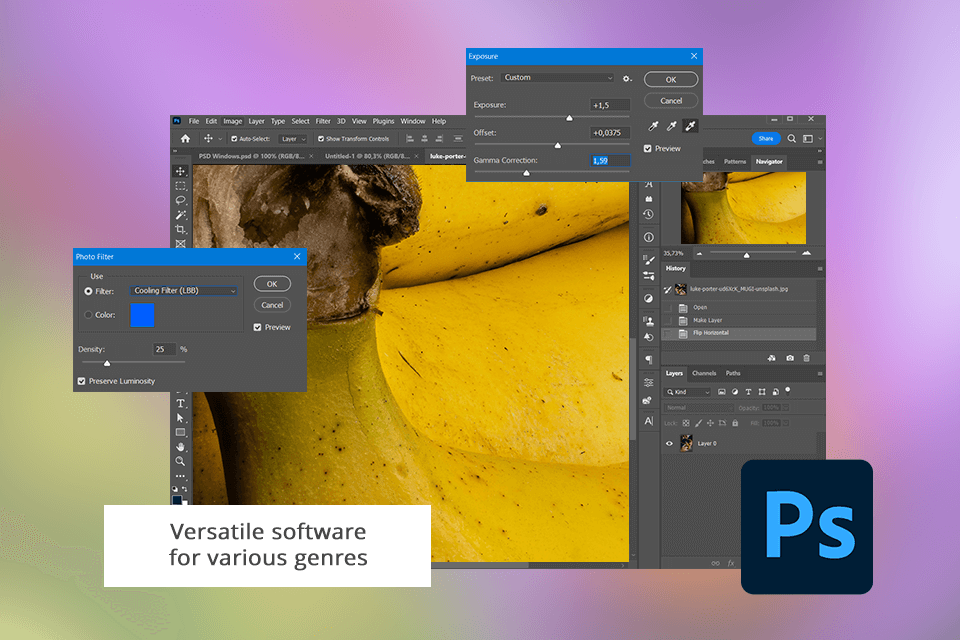
I thought of comparing Zerene Stacker with Photoshop because I normally use Photoshop tools with which I am familiar in my workflow. But when I decided to do macro, I realized I’d like to find a program designed for focus stacking specifically.
Zerene Stacker is also a very easy tool that now I love using for its functionalities, like saving preferences and batch processing capabilities. In the perspective of Photoshop, this is one very versatile software that I can literally put to use for any kind of work with photographs, graphics, website elements, etc. but focus stacking is just one of those it can do.
My recommendation for photographers who need focus stacking software to improve the quality of their work and level up the photography with the help of Photoshop. Its subscription includes all possible apps for editing and photo management – so it’s a smart choice for any art-related user.
|
|

Zerene Stacker
|

Photoshop
|
|
Rating |
★★★★☆ 4/5 |
★★★★☆ 4.5/5 |
|
Best For: |
Macro photographers |
Photographers of all genres |
|
Free Trial |
✔️ |
✔️ |
|
Price |
$89 |
$22.99/mo |
|
Platforms |
Windows, Mac, Linux |
Windows, Mac, Web |

My detailed Zerene Stacker vs Photoshop analysis showed that both programs have excellent stacking abilities, as they preserve the details on the edge of the frame.
Also, both programs need a bit of cropping which is to be expected when moving a lens element or lens. The pictures processed in Photoshop feature a high level of detail with few artifacts. Whereas pics edited in Zerene Stacker D-Map mode feature some wavy lines.

For beginner photographers, Zerene Stacker is a perfect option as it is intuitive and user-friendly. After downloading Zerene Stacker, I got the ability to align and stack multiple photos in just several clicks to create a detailed and vivid composition. As a result, I got beautiful and amazing my cat pics with the improved depth of field and overall image quality as you can see above.
Batch processing mode is one more advantage of this software, as it allows stacking many pics quickly and efficiently, accelerating my workflow. Besides, it is possible to choose from Pmax and DMap merging methods to achieve the desired level of detail and sharpness in the resulting pic. The retouching tool is absolutely straightforward and allows removing imperfections in stacked photos.

The stacking feature in Photoshop is incredibly helpful as well. It allows the creation of amazing pics with the increased depth of field and sharpness as you may see the photo of banana above. The ability to merge several pics of the same object lets me produce pro-level and eye-grabbing pics.
Moreover, Photoshop has a range of other useful options including such Photoshop AI tools as Generative Fill and Generative Expand that allow enhancing pics in a flash. Besides, there are more than 30 Adjustment Presets for refining the overall look of an image in just one click.
I’ve already tried stacking images in Photoshop many times, so for me performing this task was a no-brainer in both tools. In Zerene, this process is more automated if compared to Photoshop. It means that aligning and stacking images in Zeren Stack is one step, and in Photoshop these actions are two separate stages.
I also tried the Lightroom plugin for Zerene, which became available after purchasing the license. It accelerated the layout processing, enriching the functionality of the Lightroom editor considerably.

In the Zerene Stacker vs Photoshop rivalry, the first option is apparently a winner in terms of speed. Zerene tool excels the competitor when processing identical pics, as the whole procedure takes about 5 minutes, whereas the same task in Photoshop requires about 12 minutes.

In addition, Zerene Stacker offers sophisticated features like slabbing and PMax mode that allow achieving top-level results with minimal post-processing.

Evidently, Zerene Stacker is better at focus stacking, making it an ideal option for those who need to enhance the level of detail and depth of field in images, but I prefer using Photoshop to perform this task. This PC photo editing software comes with multiple features for refining close-ups and landscape pics. Besides, it integrates with Lightroom and other Adobe products that I require in my workflow.